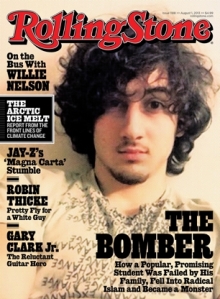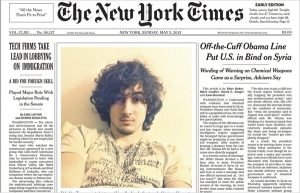Rolling Stone [full disclosure: my grad-school beer-money provider and record-shelf-filling helper] is in the hot seat just now for selecting as its current cover photo not an Annie Leibovitz or Mark Seliger portrait of a celebrity, but a “selfie” cameraphone shot of 19-year-old Dzhokhar Tsarnaev, the alleged Boston Marathon bomber who’s still alive. This image has caused a tsunami of outrage, especially in New England, where the vicious April 15 attack that killed three and wounded 264 others still has many in a state of shock.
Some companies have banned the issue outright. First, New England-based CVS/Walgreens and Tedeschi Foods announced their refusal to sell it. They were later joined by – as of this posting – Rite-Aid, Kmart and 7-Eleven company-owned stores (the home office will encourage its franchisees to follow suit). Knee-jerk cries of “censorship” have inevitably followed, but this is a tough moral call for many of my well-meaning friends, who are really wrestling with the issue. I am too.
The first thing we think of has to be the hundreds of victims and their anguished loved ones. That’s why we can understand the outrage even when we don’t share it in a visceral way. What would we do in their place? Probably scream and shout – and weep – as well. Grief isn’t rational, and it hasn’t been that long since half a million people came out on a beautiful spring day to celebrate a Boston tradition and cheer on their heroes. This wound is only beginning to heal; it’s still there.
Note that there’s little objection (in fact, I haven’t heard any at all) to Janet Reitman’s cover story itself, a fine piece of journalism that you can read here (make note of the editors’ response to this controversy at the head of the piece). It calmly depicts how the kid next door could turn into a radical and ultimately a monster, the precise word used on the cover. The troublesome part isn’t even the image itself. It can’t be. Back in May it was printed on the front page of the New York Times, in color, in the center, above the fold, and nobody said a word.
What bothers people is the juxtaposition of this image with Rolling Stone, and the outrage has to come largely from people who don’t read Rolling Stone (let’s be honest, that’s most people). I infer this from comment after comment decrying the magazine’s “glorification” of an alleged murderer. From the outside, Rolling Stone probably looks something like Tiger Beat: it’s only youth culture, the cover should rightly depict nothing more profound than the latest rocker or pop-culture sensation. Heck, getting on the cover even inspired a Top Ten novelty hit in 1973. What outsiders don’t realize is that Rolling Stone is one of the last bastions of long-form journalism, and has been practicing this venerable profession since its founding. Not a single issue goes to press without at least one piece, maybe even the cover story, which has nothing to do with show business but is meant only to inform and illuminate its readers on the issues of the day. Longtime RS readers were not surprised to see this image on the cover, only found it remarkable for its stated purpose. Here’s your bomber, this…kid.
“They made him look so glamorous.” Nope, it’s only a selfie, that’s you doing that, by virtue of his proximity to the Rolling Stone logo. What you can’t tell from looking at the digital image above, what you can only suss by holding the printed copy in your hands, is that unlike most of RS’s cover portraits, on which you can damn near see individual hair follicles, this photo began so low-res that, blown up for the RS cover, it almost loses focus; here, you can see pixels. In person, it registers instantly that this shot was clearly taken by the subject with a cameraphone. Like the selfies you take. He’s a tousle-haired teenager with a mobile phone, just like RS’s core audience, and that can’t help but unnerve some of them. The image’s power issues from its very normalcy: to any even remotely contemplative kid, it’s uncomfortably like looking into a mirror. Which leads to…
“He’s become a role model. He’ll inspire others.” Any kid unhinged enough to view what Tsarnaev allegedly did as a good thing, to conclude that being on the cover of Rolling Stone is worth an act of mass carnage, will be sorely disappointed to find that they’ve already done their terrorist cover. Besides, we’re full of enough self-hating, gun-toting, random-snuffing “role models” to satisfy a nation of over-armed, sick depressives, and nobody does boo about that, not even when the victims are a room full of first graders.
“They just did this to make money.” I would strike the word “just,” but they publish every issue to make money, and choose every cover subject to attract attention. Will newsstand sales of this issue spike? You’ve already seen the cover, and you can read Ms. Reitman’s story with a single click, so maybe not – especially since it won’t be available at all those outlets. But as New York Times media columnist David Carr wrote, when’s the last time somebody asked you, “Have you seen the cover of Rolling Stone?”
You have the right to decline to sell anything you like. (As a Times editorial pointed out, in CVS’s case, this means cigarettes are fine, Rolling Stone not so.) You also have the right to refrain from patronizing a particular company for whatever reason you like: an ugly logo, a surly server, an act of censorship — or a cover image that offends you. It’s as simple, and as complicated, as that.






 Posted by Tom Dupree
Posted by Tom Dupree 